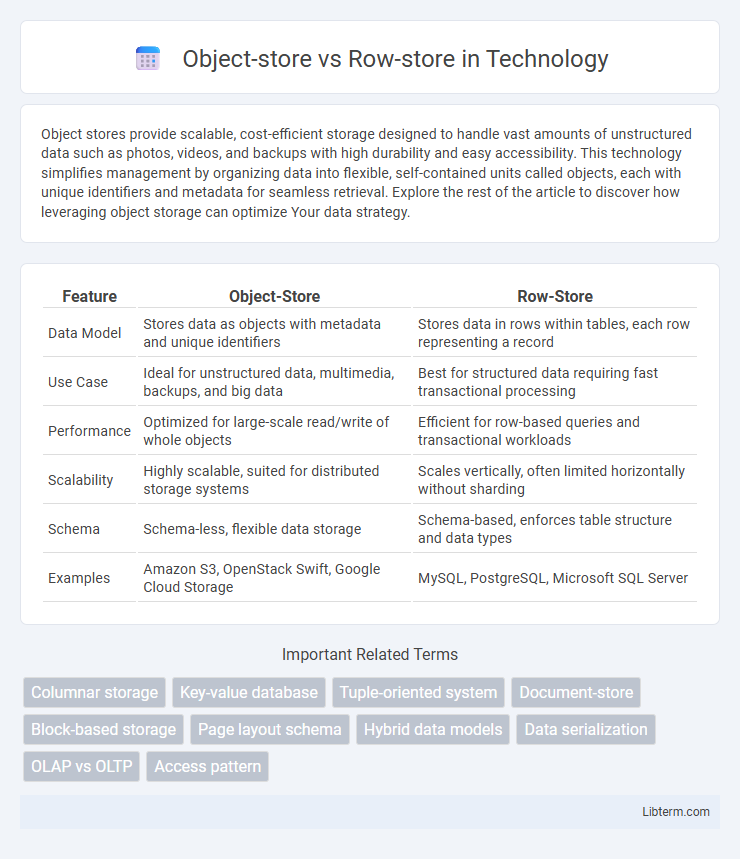Object stores provide scalable, cost-efficient storage designed to handle vast amounts of unstructured data such as photos, videos, and backups with high durability and easy accessibility. This technology simplifies management by organizing data into flexible, self-contained units called objects, each with unique identifiers and metadata for seamless retrieval. Explore the rest of the article to discover how leveraging object storage can optimize Your data strategy.
Table of Comparison
| Feature | Object-Store | Row-Store |
|---|---|---|
| Data Model | Stores data as objects with metadata and unique identifiers | Stores data in rows within tables, each row representing a record |
| Use Case | Ideal for unstructured data, multimedia, backups, and big data | Best for structured data requiring fast transactional processing |
| Performance | Optimized for large-scale read/write of whole objects | Efficient for row-based queries and transactional workloads |
| Scalability | Highly scalable, suited for distributed storage systems | Scales vertically, often limited horizontally without sharding |
| Schema | Schema-less, flexible data storage | Schema-based, enforces table structure and data types |
| Examples | Amazon S3, OpenStack Swift, Google Cloud Storage | MySQL, PostgreSQL, Microsoft SQL Server |
Introduction to Object-Store and Row-Store Databases
Object-store databases manage data as objects, integrating both the data and metadata for flexible storage of diverse data types like images, videos, and documents, ideal for unstructured data. Row-store databases organize data in rows, optimizing transactional operations by allowing fast read and write access to entire records, commonly used in traditional relational database management systems. Understanding the differences in data organization and access patterns helps in selecting the right database technology for specific application needs.
Core Architectural Differences
Object-store databases organize data as discrete objects containing both metadata and content, enabling efficient storage and retrieval of complex, nested data structures. Row-store databases store data in table rows, optimizing for transactional workloads by accessing entire records quickly and supporting fast point queries and updates. The core architectural difference is that object-stores emphasize encapsulated data with rich metadata for unstructured information, while row-stores prioritize flat, tabular data optimized for relational operations.
Data Modeling Approaches
Object-store databases model data as objects, encapsulating attributes and behaviors suited for complex, hierarchical data structures and applications requiring rich data types. Row-store databases organize data into rows, optimizing for transactional workloads with flat, tabular relationships, where each row represents a complete record facilitating quick retrieval and update operations. Choosing between object-store and row-store data modeling hinges on use case requirements, data complexity, and the need for schema flexibility versus normalization.
Performance and Query Optimization
Object-store databases optimize performance by storing complex data types as self-contained objects, reducing the need for multiple joins and improving retrieval speed for hierarchical or unstructured data. Row-store databases excel in transaction-heavy environments by storing data row-wise, enabling faster write operations and efficient access to entire records, which benefits OLTP systems. Query optimization in object-stores leverages object indexing and path expressions to access nested attributes quickly, while row-stores use indexing strategies like clustered and non-clustered indexes to expedite filtering and sorting within relational tables.
Scalability Considerations
Object-store databases excel in scalability by distributing data across multiple nodes, enabling efficient handling of large-scale, unstructured datasets. Row-store databases typically face challenges scaling horizontally due to tightly coupled row-based storage, which limits performance as data volume grows. Advanced object-store systems leverage distributed hashing and replication techniques to ensure high availability and low-latency access in expansive environments.
Use Cases and Ideal Applications
Object-store databases excel in managing large volumes of unstructured data such as multimedia files, IoT sensor feeds, and backups, making them ideal for cloud storage, big data analytics, and content management systems. Row-store databases are optimized for transaction-heavy applications requiring fast read/write access and complex querying, such as OLTP systems, CRM platforms, and real-time analytics. Selecting the appropriate storage model depends on use cases that prioritize flexibility and scalability for object-stores versus low-latency transactional consistency for row-stores.
Storage Efficiency and Overhead
Object-store databases optimize storage efficiency by grouping data as discrete objects, reducing fragmentation and minimizing metadata overhead compared to row-store systems, which store data in fixed-length rows often leading to wasted space in sparse tables. Object-stores handle variable-sized or hierarchical data more efficiently, as their storage model aligns with the natural data structure, decreasing the need for padding and padding overhead. In contrast, row-stores introduce more storage overhead through null values and consistent row lengths, which can inflate storage requirements especially in wide or sparse datasets.
Transaction Management and Consistency
Row-store databases excel in transaction management and consistency by supporting ACID-compliant operations with fine-grained locking and real-time concurrency control, ensuring immediate data integrity during transactional updates. Object-store systems, while optimized for unstructured data, often rely on eventual consistency models and may use versioning or conflict resolution mechanisms, which can complicate transactional guarantees in multi-user environments. The choice between row-store and object-store impacts application requirements for strict consistency versus scalability and flexibility in handling complex data types.
Integration with Modern Technologies
Object-store databases integrate seamlessly with cloud-native applications and big data platforms, supporting unstructured data formats like JSON and multimedia files through APIs compatible with REST and GraphQL. Row-store databases excel in transactional systems with strong ACID compliance, integrating tightly with SQL-based analytics tools and traditional OLTP environments. Both storage models are increasingly adapting to leverage container orchestration and microservices architectures for scalable, high-performance data processing.
Choosing the Right Solution for Your Needs
Object-store databases excel in managing unstructured data like multimedia files, making them ideal for applications requiring scalable storage and fast retrieval of large objects. Row-store databases provide efficient transactional processing and quick access to individual records, which suits applications with structured data and frequent updates. Selecting the right solution depends on data type, access patterns, and scalability requirements, where object stores optimize for large, diverse datasets and row stores prioritize speed in transactional workloads.
Object-store Infographic

 libterm.com
libterm.com